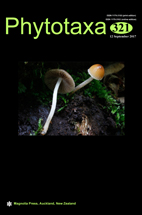Abstract
Russula ahmadii, a new species and its ectomycorrhiza are described and illustrated from coniferous forests of Pakistan, based on morphological characteristics and molecular phylogenetic data. The species is characterized by small to medium size basidiomata, a dark brown to greyish brown, tuberculate striate, and depressed pileus with dark brown spots in the centre, a chambered stipe having brownish patches towards the base, globose to subglobose amyloid basidiospores, having covered with bifurcated verrucose ornamentation connected by partial reticulum. Its ectomycorrhiza is typical of the genus Russula and is characterized by the presence of abundant lageniform cystidia with a straight neck and branched emanating hyphae with frequent clamp connections. Phylogenetic analyses based on ITS and LSU sequences support erection of the new species. Phylogenetic network analysis revealed its close position to R. pectinatoides. ITS sequences from ectomycorrhiza of Cedrus deodara also clustered with sequences from basidiomata of R. ahmadii confirming its mycorrhizal status. Phylogenetic analyses and morphological features placed the new species in R. section Ingratae.

